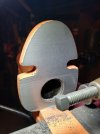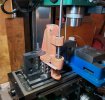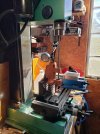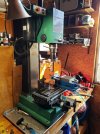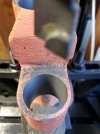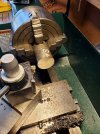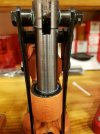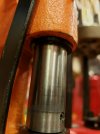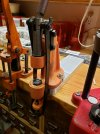Ian ,
Just loose thoughts about wear , bushings , oil , seals , pressure , sort of all balled up , inspired by your description of the parts and my very worn Partner press .
In aviation we have an axle/shock assy referred to as an olio strut not really too different from the McPherson type except it has a knee type travel stop that also keeps the alignment .
In typical form they have a 10-14" travel . Time is harder on the seals than miles .
Basically the assy is a tube with an upper and brass bushing , 2 "O" rings or chevron seals , a scrapper to keep the big chunks out . The axle and piston are one piece and just slip up inside the tube . I've taken apart a dozen or more the upper bushings rarely have enough wear to to give them a second look . That's hard chrome or polished chrome moly that travels 3-3-1/2 feet per cycle more in windy areas less maybe where they live in hangers .
The bottom bushing however takes up the alignment , side load , and shock loads . A 24" lever attached to an 8.00-6 tire that accelerates from 0-50 possibly 110 mph in 25' with as much as a 10-15 degree out of run line side load while 13-1400 lbs drops on it isn't something that gets a lot of wear but peens a lot .
The seals manage to contain 60-100 psi of air over oil unloaded and up to 1200 psi sitting . I've seen them hold well with a lot of movement ...... Stay with me .
It seems to me that a bronze bushing to carry the alignment load with a softer than the ram steel/iron thrust load ring on the side loading handle/knee end should all but eliminate wear with a polished ram . Having a kiln on hand you should be able to do a nitride hardening of the ram , it's sometimes also called Melonite treating though different functionally it's the same . Heat the parts expose them to an ammonia fog , viola' black chrome that holds oil like cast iron . An all steel bushing so treated against a treated ram will be sticky though , even swimming in oil .
Following the above the steel insert would would take all of the side/out of line load and shift it to an alignment load . Unless the ram shape changes the "funnel" effect on the bushing from below should be gone and the rest of that load will be at a minimal load on the top of the bushing without a complex tapered ram or bushing .
